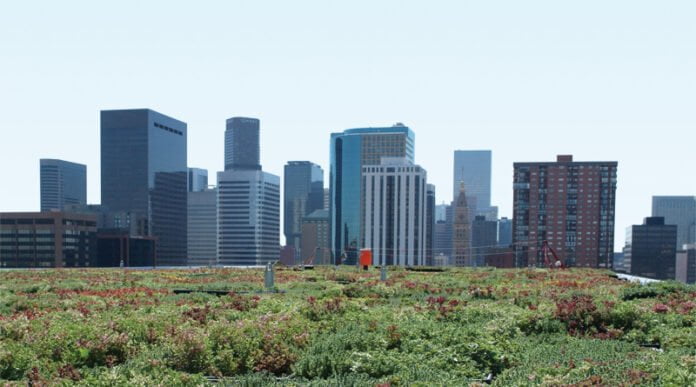In November 2017, Denver voters approved by over 54% an initiative that would have required new buildings and roofs over 25,000 square feet to be covered to some extent by a green roof. The Green Roofs Review Task Force released a draft policy in mid-June that outlined in more detail how a final regulation might look.
On Oct. 29, Denver City Council voted unanimously to approve the amendments suggested by the task force. The ordinance requires most buildings to install a combination of a cool roof and other improvements, such as a green space, solar or other renewable energy, or paying into the green building fund.
Andy Creath, founder of Green Roofs of Colorado in Denver and a board member for the Green Infrastructure Foundation, is optimistic about the impact the ordinance will have on the local industry.
“It’s specialized and it’s all local,” Creath said of the initiative’s reach. “It’s all designers and landscape architects in Denver Metro who are going to be getting this work because it’s a very site-specific and very location-specific rule.”
The ordinance provides landscape architects, designers and contractors with new opportunities, but there are special considerations for designing these types of projects.
One of the challenges with installing green roofs on existing buildings is that they may need structural upgrades to support the weight of a green roof or to prevent drainage problems, according to Colorado Springs-based landscape architect Kristin Heggem.
Creath added that “the structural stability of the building, proper drainage and a really well-defined waterproofing membrane are the first three things we look at on any project.”
Designing for life
Heggem said the design process “usually starts with the owner, of course, and finding out how they want to program the space. What do they envision? What kind of project is it?”
For example, multifamily buildings may use green-roof space for exercise stations, dog walking areas or outdoor kitchen and dining spaces, she said. An office building may want shaded areas where workers can take breaks.
Once the client’s vision for the space is outlined and the budget is nailed down, Heggem said it’s important to think about the accessibility of the space, not just for the end users but for the contractors who will need to get materials to the roof. Designers should also think about how maintenance workers will access the space throughout the lifespan of the green roof, including the landscape maintenance workers who will tend to plants and any building maintenance crews who might need to access air conditioning units or other rooftop structures.
Cost is one of the main objections to installing a green roof, and Heggem acknowledged that a green roof can cost two to three times as much as a traditional roof. However, Creath noted that a green roof might also last two to three times longer than a traditional roof. He said that building owners who install green roofs should expect to see a return on their investment over about six years.
Heggem added that building owners can defray the cost of a green roof through grants that fund green infrastructure projects including green roofs, Heggem said, while the Property Assessed Clean Energy (PACE) program provides funding for energy efficiency improvements.
Furthermore, cities will often use “an expedited approval process if you include a green roof in your plan,” Heggem said.
She noted that the last two green roofs she worked on were before Denver’s initiative passed, but “developers already knew the return on their investment.”
“Their buildings are worth more. They get higher LEED rates,” she said. “They were already seeing the value of it. I think Denver’s initiative passing is just going to reinforce all of that.”
Related: Benefits of green roofs
Creath agreed that some professionals will be better prepared for the final rule.
“You have different degrees of developers to this process,” he said. “The roofs we’ve been working on recently have been somewhere between 3,000 and 4,000 square feet of additional space, but they’re looking to do planted gardens and vegetable beds. The people who are doing that already, the initiative doesn’t affect them because they’re already doing it.”
He continued, “the people who have to catch up are going to have a bigger hit on their financial issues.”
New partners
Landscapers who take on green-roof projects will find themselves working with partners they’re not familiar with, like structural or civil engineers.
“There’s a water quality element in green roofs: collecting the water on the roof, getting it to drain properly,” Heggem said.
Collaboration is important, Creath said. “The earlier you can get a professional on board like a landscape architect and someone who studied this stuff and has seen and implemented [a green roof], the better for the project.”
Creath added that because a green roof will be the last step in new construction, problems at that stage can be expensive and complex.
“The green roof is the topping on all of these other structures that work together, so we look for a collaboration angle for the entire design community: landscape architects, architects, structural engineers, contractors,” he said.
Landscapers who want to make the most of opportunities raised by the new initiative should consider pursuing designations that highlight their qualifications on these types of projects.
The Green Roof Professional designation, administered by the Green Roofs for Healthy Cities, covers design and installation, waterproofing and drainage, and plants and growing media. GRHC launched the program in 2009, and since then, over 750 individuals have earned the designation.
Creath said that since Denver voters approved the initiative in November 2017, about 15 professionals have earned the designation, which he says is the “standard for green-roof training at this point.”
Greening single-family roofs
The primary goal of the initiative is to reduce the urban heat island effect, which is when urban areas experience hotter temperatures than surrounding neighborhoods due to the prevalence of impervious and reflective surfaces, as well as the energy generated in high-density areas.
However, some affluent clients may be interested in incorporating green-roof designs on single-family homes. Creath’s firm has done several single-family green roofs of different sizes and different budgets.
“In the first half of 2018, we built about 15 residential green roofs,” he said. “Maybe they’re taking advantage of a garage or something with a flat roof, or some area in between two structures where they want to create a place that’s a little more accessible and usable.”
Creath said that residential green roofs are part of a “very busy market.”
“It tends to be on a higher-end homes and new construction,” he noted, although “if you’re popping a top, you can build in the structural stability to do a new green roof without breaking the bank because you’re already adding structural components to it.”
Even homes with pitched roofs can have a green roof installed, Creath said. With special engineering, green roofs can be installed on roofs with a pitch up to 40 degrees, he noted.
Green-roof ‘workhorse’
Sedums and succulents are among the most successful plant types for green roofs, Heggem said, thanks to their root structure and tolerance for drought and wind. However, designers and landscape architects have several options to choose from.
“There are a lot of other choices as long as there’s soil and other infrastructure to support those plant choices,” she said. “It really depends on the type of green roof that you’re doing, whether it’s intensive or extensive.”
Intensive green roofs use deeper planting mediums that allow for longer root systems. Extensive green roofs typically involve shallower mediums of six inches or less.
“That soil depth really determines what you’re able to do,” Heggem added. “Those types of root systems depend on a lot of things like structural load.”
Although sedums are the “workhorse of the green-roofing world,” Creath said, he noted that in the Denver market, they may struggle in higher temperatures we have on rooftops here.
His firm has installed special irrigation systems to make sure they can keep roof temperatures cool, but they’ve also incorporated a lot of native plants and grasses.
“We use a lot of local and native plants that do well in Colorado because they grow in a very similar type of growing media, where they grow in broken-down granite and pine mulch. Our foothills are very similar to the aggregate base green-roof media that we grow them in on the roofs.”








